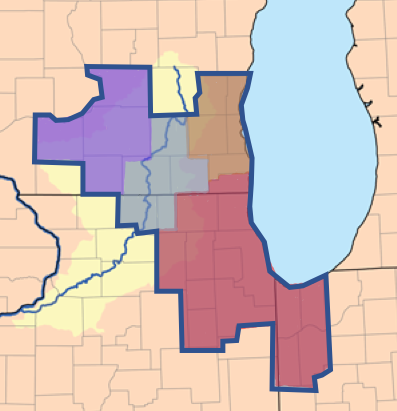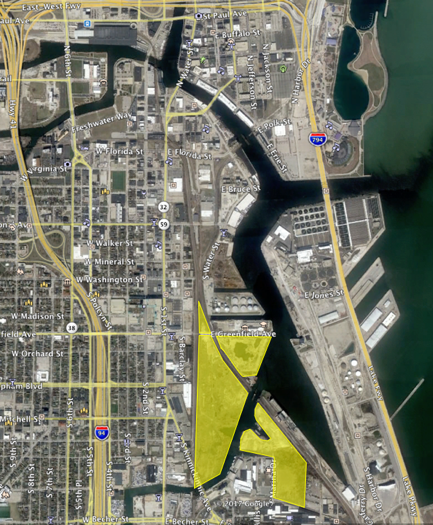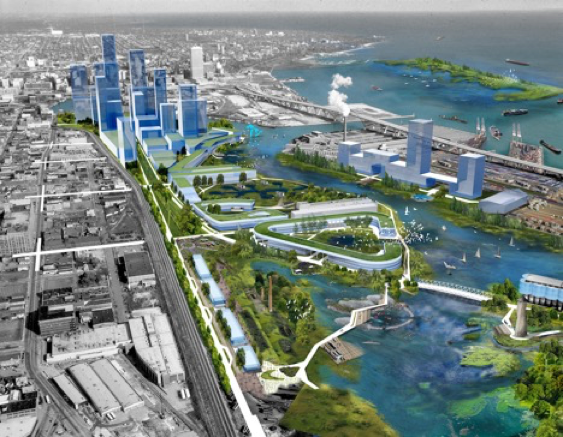Amazon and the Harbor District
Last week I said that Milwaukee deserves the new Amazon HQ, and that I think we could win the beauty contest that is their Request for Proposals process. I believe Milwaukee has remarkable strengths that offset its weaknesses. And, I believe that two of our greatest strengths are our proximity to Madison and to Chicago. In short: I believe Chi-Waukee-Son presents a remarkable opportunity.

Of course, believing we can win and presenting ourselves well enough to win are totally distinct. It’s not enough to want something. We need to use our remarkable work ethic and go get it.
I believe our greatest strength is our geographic and cultural role, not alone, but in our region. That means we need to provide a cohesive and comprehensive presentation of our regional strengths. But regional strategy is complicated in the best of cases.
We think parochially here. In Milwaukee, we tend to think about Ozaukee, Washington and Waukesha Counties as more distinct from, than similar to, Milwaukee County. And Waukesha competes with Milwaukee every day for businesses and residents (see Fiserv). So, even conceptually, how can we present Chi-Waukee-Son as a cohesive whole?
While I am hopeful we can collaborate regionally and craft a collective strategy and presentation, I’m not holding my breath.
To be fair, there are terrifically capable folks working on regional issues. The M7 was launched in 2005 and focuses on cooperative economic development in southeastern Wisconsin’s seven counties. They were integral in attracting Foxconn. The Alliance for Regional Development is a coalition of high-level leaders from Illinois, Wisconsin, and Indiana working to strengthen the economic competitiveness of Chicago’s tri-state region. And there are others.
But, it’s not entirely clear to me how those entities work together with local government and other local stakeholders to craft collective vision and action plans. Those folks are next level thinkers and planners. And that’s, in part, what we need. At the same time, we need to present our virtues and we need that message to be delivered from the full spectrum of stakeholders in the outcome. Amazon needs to know that they would have the support of our political and business communities, as well as the support of our residential and cultural base.
The regional approach may prove to be too difficult. Regardless, we need to assess our greatest strengths and present them. Physical proximity, and cultural similarity, play in our favor. Whether Madison and Chicago come on board, or not, we still have those assets. And our presentation should highlight the remarkable human and economic resources our region and our city offers. We can do that.
This all begs the question: where would Amazon go? Foxconn chose this region for any number of reasons. They are going into the submarket between Milwaukee and Chicago. But they need a truly enormous piece of land. And proximity to Chicago and O’Hare absolutely played a role. But Amazon has far greater flexibility. They can go to a downtown. They can come to our downtown.
For us to really make this proposal work, we need to present Milwaukee and its unique offerings. And we can’t treat this as an opportunity to solve all our issues. We need to sell that we are the absolute right place for Amazon to go. They need us. We don’t need them, but boy would we like to have them.
In addition to the cultural, natural resource, geographic proximity, and human capital resources we can offer, Milwaukee also has a remarkable real estate opportunity. In fact, I believe we may present what could fairly be considered a singular opportunity: nationally.

When driving over the Hoan Bridge and 794 and looking down, many folks see a vast industrial wasteland. In fact, it’s exactly that urban landscape that seems to contribute to Milwaukee’s self-awareness as the rust belt: shuttered or underused buildings; crumbling infrastructure; and, environmental challenges.
When I look down, I see incredible opportunity.
This map presents an incredible site. Consider this: the Solvay Coke site alone is 46 acres (the largest of the parcels on the map). WEC recently purchased it, but it likely remains a viable parcel for the right user. Then, consider the balance of the inner harbor. Together, this presents up to 100 acres of developable land. Yes, there are environmental issues. Yes, there are plans in the works for development there. Yes, there are existing businesses (and some large-scale buildings that could work for a company like Amazon). But, we’re talking about up to 100 acres located in the heart of Milwaukee, with a blank canvas for design and development.
This site can be a national case study for urban redevelopment. It can offer iconic design. It can offer remarkable water resource adjacencies. It checks all the boxes on population, proximity to an international airport and proximity to the freeway system. It also offers dynamic potential connections to rail transit and could help to catalyze incredible infrastructure investment. And, it can accommodate their size requirements for both Phase 1 and later phases.

On behalf of Harbor District, Inc., Studio Gang put together this beautiful representation of what the Harbor District could look like if it was built out with a cohesive strategy. It’s nothing short of stunning. And, this doesn’t even contemplate the additional sites throughout Milwaukee. Notably, the Arena District offers a compelling opportunity for an iconic building. So too does the parcel on Clybourn and Lincoln Memorial Drive. And the Italian Community Center has a dynamic holding. And there are far more.
Milwaukee is a remarkable place, whether we think it is or we don’t. And, regardless of whether we can find a way to collaborate constructively with Chicago and Madison to leverage our proximity and collective strengths, Milwaukee will remain the lynchpin to Chi-Waukee-Son.
If we don’t try for Amazon, we definitely won’t get it. Even if we do try, we might not get it. But if we do try, we may change the way we look at ourselves, and the way we present our opportunities to the market. It’s time to own our assets and it’s time to present them to the market. Chicago and Madison, in some ways, are ours as well. And, on top of all of that we are smart, kindhearted, hard-working folks. Amazon just may deserve us.



